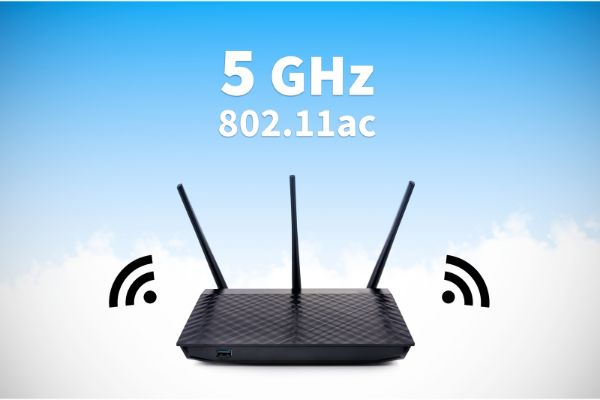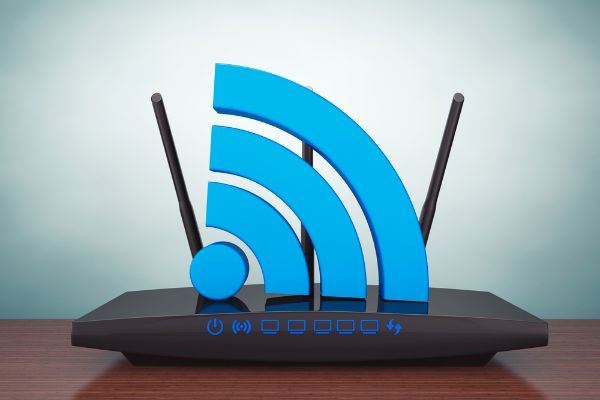Disclaimer: This post may contain affiliate links, meaning we get a small commission if you make a purchase through our links, at no cost to you. For more information, please visit our Disclaimer Page.
Many people are on the internet every day across the globe, and they use it for important business, personal reasons, or entertainment purposes. Various internet service providers build or pay for infrastructure to set up everything that is necessary for offices and homes to get a signal.
Once they do all of that, each business owner or individual user sets up some extra equipment to extend that signal to each of the devices they might own and use. Typically, people will do this through a home Wi-Fi network that uses a router. Each device that gets a signal from that router is a client. Many routers operate on either a 2.4GHz or 5GHz band, although some models can switch between both of these.
Some people prefer to work with the 5GHz band, but they also wonder if there is any way for them to extend the overall range of this band. We will go over this topic in today’s article. Additionally, we will talk about some of the specifications of the 5GHz band and how it differs from its 2.4GHz counterpart.
These facts might include why the range on the former seems so short, which extenders might work for making that range cover more of an area, and whether devices that run on 2.4GHz can connect to a Wi-Fi network that is using the 5GHz band. We’ll also discuss whether users can connect to both bands simultaneously.
Table of Contents
Why Does 5GHz Have a Shorter Range?
When we talk about 5GHz being shorter, we mean that it is shorter in range than 2.4GHz. This fact can confuse many newcomers who are just learning about how wireless bands work, because 5GHz looks like it should be bigger than its cousin in all ways.
However, higher frequencies, such as 5GHz rather than 2.4, have shorter wavelengths. Here is where we get into some of the basic mechanics of radio frequencies and waves. The shorter wavelength means that it is easier for other objects to reflect the signal back rather than let it through.
Things like walls, doors, and other solid objects can interfere with the transmission of the 5GHz wave. This is also true for the 2.4GHz band, but interference doesn’t have as big an impact on it.
However, it is worth noting that the 2.4GHz band has a lower range of data than its counterpart. Although the range is longer, and even though the band penetrates through obstructions more easily, it works with a lower data range that is prone to interference.
This interference comes from things other than walls and the like causing disturbances that can interrupt the signal. The 5GHz band might have a harder time getting through solid objects, but the signal itself isn’t as prone to interruptions if it does get through.
All of this may seem a bit technical, but it is important to understand some of the key differences between the two bands. This is because each one has situational viability that can be important for people who need to complete different tasks in different ways while maintaining solid online connections.
Before we move on, we should talk a bit about Wi-Fi speeds. You will get a speed that your internet service provider caps when you sign up for their services. Typically, this is based on the tier of service for which you pay, although your ISP may have limitations on the top tier of speed that they offer to clients. The range for a 5GHz band is more narrow than it is for 2.4GHz, but it should offer users faster internet speeds.
Of course, much of this is depends on how you set up your network and what kinds of services you get from the ISP, but it is a general guideline you can follow when you work with different bands.
This does not mean that you won’t get adequate speeds from a 2.4GHz band, but the former cuts through clutter on the network better than the latter, even though 2.4GHz can cut through objects better. This means that the speed potential for 5GHz tends to be greater.
Can the 5GHz Wi-Fi Range Be Extended?
Yes, you can extend the range of your 5GHz band. One of the best ways to do this would be to install additional access points in the home, office, or other space. You could also look into range extenders, and we will cover both in this section.
An access point is a device that uses specific hardware and settings to help it create a wireless local area network, often something people just abbreviate as ‘WLAN’.
Having more than one access point like this is usually the most beneficial when you are working in a large office building with multiple floors. However, it can work well for larger homes, too.
Typically, you’ll connect an access point to an existing router or hub using an ethernet cable. In most cases, you’ll use an access point somewhere that might be halfway between your router and the zones in which you don’t have coverage.
Provided your cable is long enough, you can have an access point on an entirely separate floor from the router itself. The point will then help to spread your Wi-Fi network’s coverage to a dead zone.
On the other hand, range extenders work wirelessly to expand the signal from your existing Wi-Fi network and spread it over a larger area. Because they are wireless, you usually need to place them in a location that still has a strong signal from the Wi-Fi router. If the signal is too weak, the range extender won’t work properly.
If we take the example of a large home, perhaps you have a router set up in the basement. The signal it produces may not reach through to the top floor of the home. Therefore, you can put an extender on the ground floor, and the original signal from the router should have the help it needs in order to get to all floors or rooms in the house.
Whether you use an access point or range extender may depend on your situation and location. Usually, a range extender is fine for most homes. It only needs to cover a few floors, and it should be able to handle as many devices as a typical family might use.
For larger businesses with more floors and more people, access points may be the wiser option. Most range extenders can only support a limited maximum of devices. This number might be too small for organizations with dozens of employees, all of whom will need Wi-Fi access in order to do their jobs.
Will a 2.4GHz Extender Work for 5GHz?
Put simply, no, a 2.4GHz extender device typically will not work for 5GHz. There are exceptions, but we’re talking about a device that only runs on the 5GHz band.
In these cases, a 2.4 version for the extender cannot help you. In fact, these kinds of extenders cannot see a device that is set to or running on only the 5GHz band.
If it cannot see it, it has no way to connect to it. You can purchase a device that will run on both frequencies, however, and then it will use whichever one is available.
Can 2.4GHz Devices Connect to 5GHz Wi-Fi?
For many of the same reasons we talked about above, 2.4GHz devices usually can’t connect to 5GHz bands. 2.4GHz is something that is now an old standard when compared to 5GHz.
Certainly, the former is still very useful for many home networks, but the two bands, and devices that might only use 2.4GHz, are different enough from each other that there are some incompatibilities.
While you cannot break the laws of physics, there might be a few workarounds that you can try. One thing you might do is purchase an extender that can handle both frequencies.
If you set this device up correctly for the 2.4GHz connection only, your devices in the home that need that one should run off of it. All your other devices should use the 5GHz band normally. Otherwise, you can also use a mobile device that can run on both bands.
If you create a hotspot with this device, you can have your other equipment that uses 2.4 GHz run off of it. This might be useful in situations where you are stuck with 5GHz Wi-Fi but have a computer that only uses 2.4 GHz.
Can I Use Both 5GHz and 2.4GHz at the Same Time?
Yes, it is possible for you to use both bands at the same time. In order to do this, two things typically need to be true, however. First, you need a dual-band router that can find and handle both of these frequencies at the same time.
Next, you need to have devices that are capable of supporting both bands. If you do, your devices should connect to whichever frequency gives you the fastest, most stable connection at any given time.
Conclusion
5GHz is a great standard for wireless connectivity that tends to give you superior internet speeds that are capable of cutting through electronic clutter quite well. However, this standard does have some trouble cutting through solid objects to bring the signal to your devices.
There are a couple of ways you can extend its short range, and which one works for you will depend on your situation. With dual-band technologies and devices that support them, you can also switch between frequencies for better connections whenever you need to do so.


